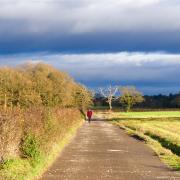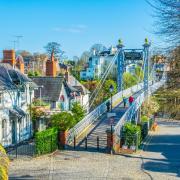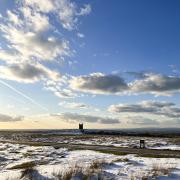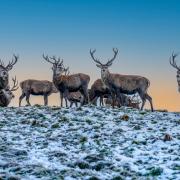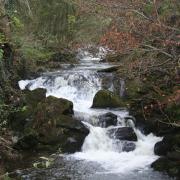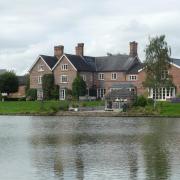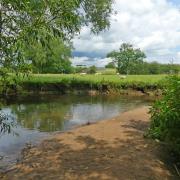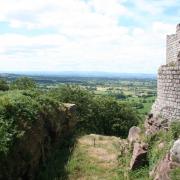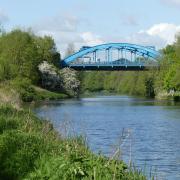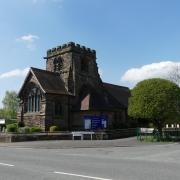
Are you a gongoozler? This picturesque term probably originated as a bargemen’s disparaging name for a passer-by gawping at operations and generally getting in the way, but was adopted by canal aficionados to describe their harmless hobby.
The word was popularised by the late L. T. C. Rolt in his 1944 classic Narrow Boat, a book describing a four-month tour of England’s inland waterways and credited with sparking the post-war revival of interest in their condition and restoration.
This varied walk certainly offers plenty of opportunities for canal-gazing, as it samples two waterways that once competed to serve the local salt trade, and features notable tunnels, locks and bridges.

Our starting point is the Leigh Arms at Acton Bridge. The striking swing bridge, a familiar landmark on the A49, was built in the 1930s to a late Victorian design.
It is rarely called into action these days, as the large commercial vessels that once serviced the Northwich saltworks are gone, and the bridge’s imposing bowstring truss is no obstruction to today’s smaller pleasure craft that chug gently along the Weaver Navigation.
Initially, we turn our backs on the bridge, heading across fields and along a stretch of the Trent & Mersey towpath to the quiet village of Little Leigh, returning to the canal at the western portal of Saltersford Tunnel. The tunnel is 424 yards long and its curve means one end cannot be seen from the other, so a timed entry system operates for narrowboats.
Bypassing the tunnel by an overland route, we return to the Leigh Arms along the Weaver Navigation via Saltersford Locks.
A side-trip to the nearby Anderton Boat Lift, perhaps including a ride on the Edwin Clark, a glass-sided observation boat named after the designer of this 'Wonder of the Waterways', would round off a dream day for the dedicated gongoozler.

1. From the car park entrance nearest the Leigh Arms, cross Willow Green Lane into the road opposite. Before the first house, turn right onto a footpath alongside the garden. Follow the path along the righthand edge of a field and through some trees to the canal. Drop down left onto the towpath and turn right, under bridge 208.
2. Follow the canal for a quarter of a mile to the next bridge, where you leave the towpath and turn left over the road bridge. Turn immediately right into a byway that runs to the right of Friar’s Rough, a scrap of ancient woodland. The path crosses a field and joins a hedged farm track, which leads out to a road.

3. Turn right into Little Leigh, passing the church on your left. When the road bends slightly left, take a signposted path on the right, by a dog bin. This hedged track narrows to a footpath beyond a gate, then after a wooden gate leads between hedges to a house. Pass respectfully and follow the driveway down to the road.
4.Turn right over the canal, then turn right onto the towpath and right again to pass under the bridge (bridge 204). Follow the towpath for a quarter of a mile to the entrance to Saltersford Tunnel. Follow the path beside the house and climb past a canal milepost and pass the top of a tunnel airshaft before descending through a metal gate to rejoin the towpath at the far end of the tunnel.
5. Follow the right-hand bank of the canal basin to a road, where you turn right, marked 'No entry' (for cars), and wind down to the River Weaver. Follow the road alongside the river to Saltersford Locks, where you cross the weir-stream and pass the lock-keeper’s house. After a second house, follow the riverside path to a footbridge over the weir-stream. Having crossed, bear left.
6. Follow the river for a mile and a half, passing through a series of gates with the wooded slopes below the canal away to your right, and, after a while, houses on the far bank of the river. As you approach the swing-bridge, you pass a brick building; ignore a farm track off to the right and continue along the riverside past the rowing club. Keep left alongside the river when the access road swings right then, before the swing-bridge, turn right up steps back to the Leigh Arms.

Compass Points
Area of walk: Acton Bridge and Little Leigh
Distance: 4½ miles
Time to allow: 2½ hours
Map: OS Explorer 267 Northwich & Delamere Forest
Refreshments: The Leigh Arms, Warrington Rd, Little Leigh, Northwich CW8 4QT, 01606 853327, www.leigharms.co.uk

The Leigh Arms and nearby walks
The main road once passed right in front of this riverside hostelry and crossed the River Weaver on the old bridge, part of which survives within the premises of the cruising club on the opposite bank. Landlady Jo Higham strives to provide a comfortable, relaxed welcome to diners and drinkers, with or without their four-legged friends. There is a large car park for patrons and a riverside garden where kids can let off steam in the play area. Real ales are from the Robinsons stable, plus guests, and there is an extensive wine list. The pub was refurbished in 2018 and is serving once more as Covid restrictions are relaxed.
A shorter walk for those lacking time or energy is to cross the main road from the Leigh Arms and head downstream alongside the River Weaver, dry-shod on the mostly traffic-free service road to Dutton Lock. Either retrace your steps along this road or follow a fieldside path to the Trent & Mersey canal towpath for the return. An alternative to the pub is Davenport’s Tearoom, on a quiet side-road on the opposite side of the A49, a quintessential English tearoom with lace tablecloths and bone-china tea service.
Slightly further afield, Marbury Country Park and Budworth Mere offer opportunities for easy strolls and casual birdwatching. Haydn Pool and Ashton’s and Neumann’s Flashes are former industrial lagoons at the Northwich end of the country park, accessible from the Witton Mill Bridge car park on the Old Warrington Road. These are well known to local birders as a draw for passing rarities.

Our new walking correspondent, David Dunford, has published five walking books, two relating to his native Oxfordshire and three to Cheshire, with more in the pipeline. Much of his leisure time is spent walking in Cheshire, often with the family of his Kelsall-born partner Rachel, who he met while researching his first Cheshire book. An enthusiastic pub-goer and more of a stroller than a strider, Dave walks to explore and observe rather than to exercise. Besides beer, his interests include old buildings and natural history, especially birds: for a decade he worked for a company providing news of avian rarities to Britain’s twitchers.




